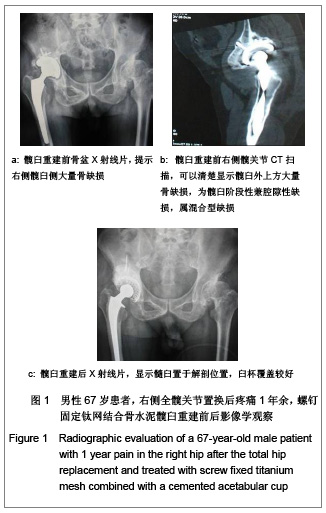| [1] Bozic KJ, Kurtz SM, Lau E, et al. The epidemiology of revision total hip arthroplasty in the United States. J Bone Joint Surg Am. 2009;91(1):128-133.[2] Zhou YG, Zhang Q, Wang Y. Reconstruction of the severe acetabular bone defect by using metal mesh and impaction bone grafting technique. Zhonghua Wai Ke Za Zhi. 2009; 47(3):172-176.[3] Kawanabe K,Akiyama H,Onishi E,et al. Revision total hip replacement using the Kerboull acetabular reinforcement device with morsellised or bulk graft:results at a mean follow up of 8.7 years.J Bone Joint Stag Br. 2007;89(J):26-31.[4] Zivkovic I, Gonzalez M, Amirouche F. The effect of under-reaming on the cup/bone interface of a press fit hip replacement. J Biomech Eng. 2010;132(4):041008.[5] Qiu XG. Beijing: The Publishing House of People’s Health.2009. 邱贵兴.人工髋关节的翻修、股骨骨缺损重建.髋关节置换并发症的诊断与治疗[M].北京:人民卫生出版社,2009.[6] Chen T,Shang XF,Hu F,et al.Linchuang Guke Zazhi. 2010; 13(5):542-544. 陈涛,尚希福,胡飞,等.机械性预防下肢深静脉血栓在全髋置换术后患者中的作用[J].临床骨科杂志,2010,13(5):542-544.[7] Luo SL, Yin F. Shiyong Linchuang Yixue. 2008;9(6):132. 罗树林,尹峰.全髋翻修术中严重髋臼缺损重建的研究进展[J].实用临床医学,2008,9(6):132.[8] d'Aubigné RM, Postel M.The classic: functional results of hip arthroplasty with acrylic prosthesis. 1954. Clin Orthop Relat Res. 2009;467(1):7-27.[9] van Biezen FC, van Gool RA, Reijman M,et al. Clinical outcomes of total hip arthroplasty after previous hip arthrodesis. Ned Tijdschr Geneeskd. 2007;151(39): 2148-2153.[10] Fernandez-Fairen M, Murcia-Mazón A, Torres A,et al. Is total hip arthroplasty after hip arthrodesis as good as primary arthroplasty.Clin Orthop Relat Res. 2011;469(7):1971-1983. [11] Alexa O, Popia I, Ciornohac F, P?duraru F, et al. Primary total hip arthroplasty in bilateral acetabular protrusion, case report. Rev Med Chir Soc Med Nat Iasi. 2008;112(2):427-431.[12] Niu SZ, Chen JY, Zhou YG, et al. Shandong Yiyao. 2009; 49(30):35-36. 牛士贞,陈继营,周勇刚,等.全髋关节翻修术后髋臼旋转中心变化对髋关节稳定性的影响[J].山东医药,2009,49(30):35-36.[13] Lian YY, Pei FX, Cheng JQ, et al. Zhonghua Yixue Zazhi. 2007;87(23):1603-1606. 廉永云,裴福兴,程惊秋,等.金属网罩结合异体骨打压植骨修复髋臼骨缺损[J].中华医学杂志,2007,87(23):1603-1606.[14] Garcia-Cimbrelo E, Tapia M, Martin-Hervas C. 1-lultisliee computed tomotgraphy for evaluating aeetabular defects in revision THA.Clin Orthop.2007;463:138-143.[15] Voigt C, Klohn C, Bader R, et al. Finite element analysis of shear stresses at the jmplant-bone jnterface Of an acetabular press-fit cup during impingement.Biomed 1-ech(Berl). 2007; 52(2):208-215.[16] Banskota AK, Shrestha SP, Banskota B, et al. Hip arthrodesis in children: A review of 28 patients.Indian J Orthop. 2009; 43(4):383-388.[17] Lia YY, Pei FX,Cheng JQ,et al.Reconstruction of acetabular defect with wire mesh and impacted bonegraft in cemented acetabular revision.Zhonghua Yi Xue Za Zhi.2007;87(23): 1603-1606. [18] Huang DY,Zhou YX,Xu H,et al.Zhongguo Jiaoxing Waike Zazhi.2007;15(23):1781-1784. 黄德勇,周乙雄,徐辉,等打压植骨结合金属网重建全髋关节翻修术中髋臼侧严重骨缺损[J].中国矫形外科杂志,2007,15(23): 1781-1784. |

